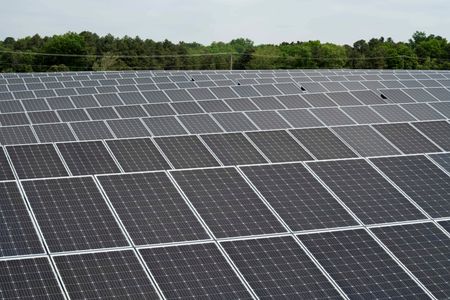By Jarrett Renshaw and Nichola Groom
(Reuters) -U.S. President Joe Biden extended Trump-era tariffs on imported solar energy equipment by four years on Friday, but in a major concession to installers he also eased the terms to exclude a panel technology dominant among big U.S. projects.
The decision represented a balancing act by the Biden administration to meet the demands of two important political constituencies: union labor which supports import restrictions to protect domestic jobs, and clean energy developers keen to access cheap overseas supplies.
The four-year extension of the tariff exempts so-called bifacial panels, which can generate electricity on both sides and are favored by large scale developers, according to a White House announcement. That technology was nascent when the tariffs were first imposed by Trump but it is now used in most large U.S. solar facilities.
The extension also doubles the import allowance on solar cells – the main components of panels – to 5 gigawatts (GW) before tariffs kick in, far more than the 2.7 GW the United States is estimated to have imported last year, according to energy research firm Rystad.
The administration also opened a pathway for duty-free supply from neighboring Canada and Mexico, which currently supply less than 1% of imports.
Domestic solar manufacturers condemned the decisions to exclude bifacial panels and to raise the cell quota, while industry trade groups representing installers and developers said they were pleased with those terms.
The chief executive of Auxin Solar, a San Jose, California-based domestic solar producer that sought an extension of the tariffs, said the bifacial exclusion and increased cell import allowance reduce “the value of the safeguard to not much more than the paper it is written on.”
First Solar Inc, which makes panels that compete with bifacial technology, said the decision “effectively allows China to outflank American efforts to grow self-reliant solar supply chains.”
Shares of the company, which is by far the biggest U.S. solar manufacturer, were down 1.5% following the announcement.
Just 1% of panels imported last year came from outside of Asia, according to Rystad.
The American Clean Power Association, a renewable energy trade group, praised the administration’s decision, calling it “a win for jobs and a win for the President’s climate agenda.”
Manufacturing makes up a small portion of the solar industry, with most of the jobs concentrated in installation and construction. Proposed legislation that would incentivize domestic solar manufacturing is currently stalled in Congress.
Former President Donald Trump imposed a four-year tariff regime on solar imports in 2018, using authority under section 201 of the 1974 trade act, in an effort to create manufacturing jobs in the U.S. solar sector. The tariffs started at 30% and declined to 15% in the final year.
Bifacial panels were initially included in the Trump tariffs but were excluded in November of last year due to litigation stemming from a series of Trump administration reversals on the issue.
The tariffs had been set to expire on Feb. 6, but Auxin and four other domestic solar manufacturers last year sought the extension, saying their products were still unable to compete with overseas-made goods that dominate the U.S. market. They cited headwinds including import stockpiling by companies before the tariffs took effect, the economic fallout of the coronavirus pandemic, and cost inflation.
U.S. panel manufacturing capacity has tripled over the last four years, with companies like JinkoSolar, Hanwha Q Cells and LG setting up module assembly plants in response to the tariffs.
However, the nation’s roughly 7 GW of panel manufacturing capacity is nowhere near enough to meet the demands of an industry that installed more than 20 GW last year. There is currently no U.S. solar cell production.
Industry trade groups had argued that the continuation of the tariffs would threaten Biden’s goal to dramatically expand clean energy and decarbonize the U.S. electricity sector by 2035 to fight climate change.
Most panels installed in the United States are made in Asia, and solar companies rely on those cheap imports to compete with energy produced from fossil fuels.
The U.S. International Trade Commission said in November after a three-month review that the tariffs were still necessary to prevent harm to the U.S. solar manufacturing industry. But the president makes a final decision on whether to provide relief to producers.
“The President agreed with the determination of the U.S. International Trade Commission and decided to extend the Section 201 Safeguards for four more years to prevent or remedy serious injury to the U.S. solar manufacturing sector,” the senior administration official said.
(Reporting by Jarrett Renshaw and Nichola GroomEditing by Richard Valdmanis, Edmund Blair, Mark Potter, Frances Kerry and Marguerita Choy)





